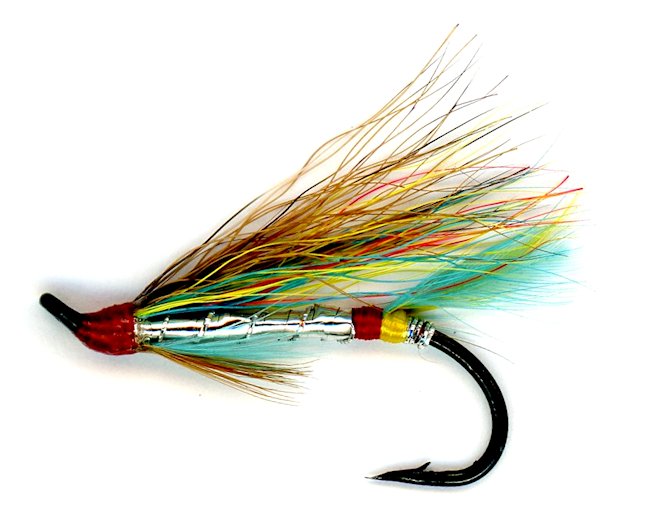The Silver Doctor Salmon Single Hook Fly
The Silver Doctor is one of the fully dressed patterns much loved by salmon anglers of the 19th century and early 20th century. The dressings of these patterns were extremely complicated and included many exotic plumages from endangered birds.

SALMON AND STEELHEAD SINGLE HOOK FLY PATTERNS. Hook size 6 8 - $US each
Modern substitute materials have enabled the Silver Doctor still to be fished. It is one of the flies that the British took to Norway and Canada at an early date with great effect. James Wright was its designer back in 1850. The silver body, red and blue coloring make this fly distinctive. Try our versions of the classic Silver Doctor Salmon fly, and Silver Doctor Double Hook Salmon fly.
I have had great success with a Silver Doctor when fishing for Salmon in Canada, Scotland and in Sweden. Bait fish have to move quickly in order to survive and your fly must do the same. Ensure you maintain your retrieve until you feel your line stop Salmon do not slam into the fly like trout or bass usually do. With Coho especially you will sometimes see a wake following your fly. Although it is exciting and can be unnerving it is important that you keep the fly moving. Do not be tempted to slow up and let the Salmon catch up. This is unnatural behavior for a bait fish and may spook your target fish into rejecting your fly. I have found Dead-drifting around the edges of swirling eddies also brings takes with this fly.
One of the most fascinating aspects of salmon fishing is the development over many years of salmon flies. For over 300 years manufacturers of fishing flies and enthusiastic anglers have worked hard to produce a salmon fly pattern that will be irresistible to their favourite fish. Over the years thousands of salmon flies in different sizes, colours and details have been produced. Some of these flies have been very basic whilst others very ornamental. Some anglers prefer lightly dressed flies whilst others sing the praises of heavily dressed fishing flies. Then there are the rank outsiders that do not use traditional methods of dressing a salmon fly. I am referring to flies like the bomber, mouse and mouserat dear hair flies.
Most salmon fly tying books and magazine articles countless different patterns and include details of how to dress them. Very few inform the reader of hints on how and when to use these flies to best advantage. They very rarely point out the importance of certain aspects of that particular fly's design and how it affects the fly in the water or why it works better than other patterns. Salmon fishermen, whether they are in Scotland, Scandinavia, Russia or North America, have to remember that the idea of using a fishing fly is to simulate an item that is part of a salmon is staple diet. It is immaterial, if the fish is taking your fly as something to feed on or just because a feeding memory has been stirred. It is sensible to conclude that no fish will try to take fly into its mouth unless it has a good reason to do so.
Before the fly tire starts to make a new fly or a flyfisherman on the riverbank chooses a salmon fly from his tackle box, they must decide what item of the salmon's natural food, they are going to attempt to imitate. In most circumstances it is going to be a smaller fish or shrimp, even if it is an attractor pattern. Only on the very small hooks will it be in insect. The salmon angler must present a fly in the most realistic and attractive manner possible so that it swims through the water in a lifelike manner and imitates the movement of a natural fish. These are vital skills he or she must learn.
The composition and size of the fly can have a significant impact on how successful the fly is in fooling the target salmon. Other variables that can effect success are how it moves in the water, any reflection it gives out and the colour contrast it has with the immediate aquatic environment. This can vary depending on water heights, rate of flow, water temperatures, quality water visibility and changing seasons.
Many fly designers made sure they produced fly patterns that represented the shape and form of a fish that also was able to cut through the water and turbulent currents, smoothly just like a natural swimming fish. Once they have got the fly's movement underwater correct, they started to add other details. The most common feature added to many salmon flies was jungle cock either side, at the front, of the fly to represent a fish eye. To simulate the movement of fins, hackle or veil feathers were added to the body. A darker top wing was a very common feature used to represent the camouflaged back of many prey fish. As most fish have a lighter underbody, many salmon fly traditional patterns like the Silver Doctor or the Silver Wilkinson have a hook shank decorated in silver tinsel to add relief and reflect light. The modern thinly dressed long feather wing and hair wing salmon fishing flies show more natural movement than the classic old feather wing salmon flies.


Salmon fishing books

